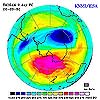| . |  |
. |
In October, the Upper Atmosphere Research Satellite (UARS) completed the first measurement of the solar ultraviolet radiation spectrum over the duration of an 11 year solar cycle, a period marked by cyclical shifts in the Sun's activity. This long measurement record by two instruments aboard UARS will give researchers better insight into how fluctuations in the Sun's energy affect ozone and the Earth's climate. In turn, the dataset gives scientists tools to document the influence of man-made chemicals on ozone loss. Though mission success was initially declared only 18 months after its launch in September 1991, UARS has continued to track ozone levels and atmospheric gases that react with ozone. The satellite has now also recorded the Sun's influence on ozone and other gases over an entire solar cycle. During the 11-year solar cycle the Sun undergoes periodic changes in activity from the "solar maximum," to a period of quiet called the "solar minimum." During the solar maximum there are many sunspots, solar flares, and coronal mass ejections, which can affect communications and the atmosphere here on Earth. "Having a complete solar cycle of data provides information necessary to distinguish the natural variations in the Earth's atmosphere from man-made variations," said Charles Jackman, UARS Project Scientist at NASA's Goddard Space Flight Center, Greenbelt, Md. "UARS has lasted so long that we now have an 11 year mission with a single set of observations spanning the entire solar cycle," said Gary Rottman, a senior scientist at the University of Colorado and Principal Investigator for the SOLar Stellar InterComparison Experiment (SOLSTICE) instrument on UARS. This complete solar cycle UV radiation dataset provides key measurements toward better determination of the roles of natural and man-made influences on ozone. Also, by observing a full solar cycle, scientists hope to use the additional data to better understand the Sun's behavior. Observatories on the Earth have found fewer sunspots in this solar cycle than the last one, but UARS measurements indicate the amount of UV radiation that struck Earth's atmosphere during each solar maximum was about the same. "The expected correlation between sunspot activity and UV irradiance over the long term was not found," said Linton Floyd, a researcher working at the Naval Research Laboratory, Washington, and Project Scientist for the Solar Ultraviolet Spectral Irradiance Monitor (SUSIM) instrument on UARS. Floyd hopes that more long-term records will help clear up such mysteries about the Sun. UARS includes ten instruments designed to understand the radiation, chemistry, and dynamics of the Earth's upper atmosphere. Of those ten, seven instruments still work. The SUSIM and SOLSTICE instruments measure UV light from the Sun and provide insights into the relationship between UV radiation and atmospheric ozone. These two instruments were independently calibrated, each providing a check on the other. Another set of instruments measure gases like ozone, methane, water vapor, and chlorofluorocarbons (CFCs) in Earth's atmosphere. The third group measures winds in the stratosphere, mesosphere, and the lower thermosphere and help researchers understand the global movement of gases. In January 2003, NASA will launch the Solar Radiation and Climate Experiment (SORCE) satellite, which will provide further measurements of the Sun. By having an overlap with UARS, NASA will have two satellites making essentially the same measurements simultaneously, thereby providing a "truthing" for comparisons and an even longer term data record, Floyd said. Related Links SpaceDaily Search SpaceDaily Subscribe To SpaceDaily Express  Greenbelt - Oct 02, 2002
Greenbelt - Oct 02, 2002Scientists from NASA and the Commerce Department's National Oceanic and Atmospheric Administration (NOAA) have confirmed the ozone hole over the Antarctic this September is not only much smaller than it was in 2000 and 2001, but has split into two separate "holes."
|
| ||||||||||
| The content herein, unless otherwise known to be public domain, are Copyright 1995-2016 - Space Media Network. All websites are published in Australia and are solely subject to Australian law and governed by Fair Use principals for news reporting and research purposes. AFP, UPI and IANS news wire stories are copyright Agence France-Presse, United Press International and Indo-Asia News Service. ESA news reports are copyright European Space Agency. All NASA sourced material is public domain. Additional copyrights may apply in whole or part to other bona fide parties. Advertising does not imply endorsement, agreement or approval of any opinions, statements or information provided by Space Media Network on any Web page published or hosted by Space Media Network. Privacy Statement All images and articles appearing on Space Media Network have been edited or digitally altered in some way. Any requests to remove copyright material will be acted upon in a timely and appropriate manner. Any attempt to extort money from Space Media Network will be ignored and reported to Australian Law Enforcement Agencies as a potential case of financial fraud involving the use of a telephonic carriage device or postal service. |